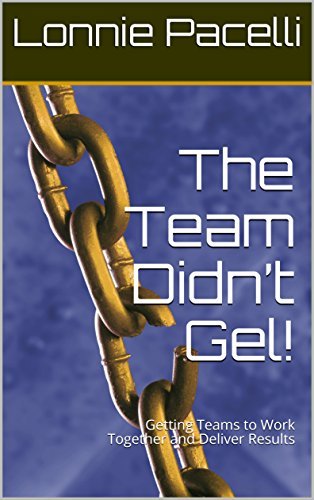Lonnie Pacelli's Blog, page 36
April 23, 2021
Free 4/28-29: The Team Didn't Gel!
 Free 4/28-29: The Team Didn't Gel!
Free 4/28-29: The Team Didn't Gel!Get it at https://amzn.to/2Kh8X4S
#freebook #teamwork #leadership #kindle #kindlefire #ebooks #ebook #Kindlefreebooks #Kindledeals #FREE #mustread #goodreads #greatreads #freebie #freebies #kindlebook #projectmanagement #leadership #PMI
Published on April 23, 2021 02:46
April 16, 2021
Free 4/21-22: The Perfect Brainstorm - Getting The Most Out Of Brainstorming Sessions
 Free 4/21-22: The Perfect Brainstorm - Getting The Most Out Of Brainstorming Sessions
Free 4/21-22: The Perfect Brainstorm - Getting The Most Out Of Brainstorming SessionsGet it at https://amzn.to/2zjXnSe
#freebook #teamwork #leadership #kindle #kindlefire #ebooks #ebook #Kindlefreebooks #Kindledeals #FREE #mustread #goodreads #greatreads #freebie #freebies #kindlebook #projectmanagement #leadership #PMI
Published on April 16, 2021 02:41
April 12, 2021
From Theory to Reality: Implementing Innovative Leadership Concepts that Stick
 Hal was a new leader over a team of six followers. He committed to his manager that he would be a “learning leader,” and read leadership books to improve his skills. Almost every month in team meetings Hal included a book report on his latest book and the leadership techniques he wanted to put into practice. At first the team was receptive, but after the first few books a pattern emerged. Hal would talk about what he learned and implement the new methods . . . until he read the newest book on his list, making the previous book’s approach yesterday’s news—pushed aside. The team grew exasperated with Hal’s technique du jour only to have it replaced with a newer model. Even worse, the theory stayed just that, theory. Hal evaluated himself based on his knowledge; the team evaluated him based on his actions. Hal ultimately lost his team leader role; all that theory never making its way to reality.
Hal was a new leader over a team of six followers. He committed to his manager that he would be a “learning leader,” and read leadership books to improve his skills. Almost every month in team meetings Hal included a book report on his latest book and the leadership techniques he wanted to put into practice. At first the team was receptive, but after the first few books a pattern emerged. Hal would talk about what he learned and implement the new methods . . . until he read the newest book on his list, making the previous book’s approach yesterday’s news—pushed aside. The team grew exasperated with Hal’s technique du jour only to have it replaced with a newer model. Even worse, the theory stayed just that, theory. Hal evaluated himself based on his knowledge; the team evaluated him based on his actions. Hal ultimately lost his team leader role; all that theory never making its way to reality.As of this writing there are over 60,000 leadership books on Amazon. Each author (including me) tries to take a unique spin on some aspect of leadership in hopes of appealing to leaders of all types. Some books have been highly influential (think The Seven Habits of Highly Effective People ), while others not so much. With so many choices on the market and new ones being released all the time, a leader can get overwhelmed with the number of authors shouting at them about how to be a better leader. Even if a leader narrows his reading list down to just a few books, he is faced with what to do with the concepts the author is peddling. Perhaps it will be a discussion topic at a staff meeting, or the basis of a team-building exercise at an offsite meeting. More often than not, the hot concepts of today stay just that: concepts. Translating leadership concepts into reality that can actually grow a leader’s skills takes deliberate action. Want to be more intentional about weaving leadership concepts into your leadership fabric? Consider these five take-aways:
Set expectations with yourself and the team – A team deserves to know what to expect from its leader, including the desire to grow leadership skills across the team. Ensure your team knows that you are an active learner and, in the spirit of growing skills across the team, want to do some leadership concept experimentation. It’s particularly important that you treat leadership experiments just like you would any project; have a goal, timeframe, activities, and any accountabilities you expect of the team and yourself.Actively learn, selectively experiment – I say this as a leadership author myself: authors are looking for provocative ideas that put new spins on leadership in the hopes it will catch fire and sell millions of copies. As a learning leader, it’s your job to filter out concepts that won’t work well in your team and only use those that have a greater likelihood of success. For example, in No Rules Rules, Reed Hastings of Netflix has instilled a culture of minimalist policies that empower employees to do things that many other companies wouldn’t permit. A mid-level leader can’t realistically implement this concept if his or her organization is more policy driven.Don’t let experiments get in the way of getting work done – At the end of the day the team still has commitments it needs to achieve. Doing leadership concept experiments is certainly fine as a means of growing the skills of a team. However, if it causes team members to burn the midnight oil to get their day job done, then the experiment will have a reduced chance of success. And team members will likely resent the experiment because it creates more work. Be open to the team’s feedback on both the frequency of experiments and how much time team members are expected to dedicate.Post-mortem the experiments – Once the experiment is complete, conduct a candid assessment of the experiment; what concepts worked well, what didn’t work well, and what concepts (if any) the leader and team agree to continue practicing. It’s perfectly acceptable to get to the end of an experiment and decide none of the techniques will pass muster. Demonstrate adaptation – As a leader, I’ve gotten all excited about some new leadership concept only to drift back to old behaviors over time. Focus on a small number of leadership improvements (between one and three) and demonstrate through action how you’ve incorporated the improvements. A team will follow its leader’s example. If you change, your team will change; if you go back to your old ways, the team will follow suit.
There’s no shortage of leadership tips and tricks any leader willing to learn can tap into. Just be intentional about what you decide to take on and focus on bringing leadership concepts to reality.
Published on April 12, 2021 02:37
April 11, 2021
Free 4/14-15: The Leadership Greenhouse
 Free 4/14-15: The Leadership Greenhouse
Free 4/14-15: The Leadership GreenhouseGet it at https://amzn.to/2S002Y0
#freebook #teamwork #leadership #kindle #kindlefire #ebooks #ebook #Kindlefreebooks #Kindledeals #FREE #mustread #goodreads #greatreads #freebie #freebies #kindlebook #projectmanagement #leadership #PMI
Published on April 11, 2021 00:00
April 2, 2021
Free 4/7-8: Set That Direction!
 Free 4/7-8: Set That Direction!
Free 4/7-8: Set That Direction!Get it at https://amzn.to/2DOTt7M
#freebook #teamwork #leadership #kindle #kindlefire #ebooks #ebook #Kindlefreebooks #Kindledeals #FREE #mustread #goodreads #greatreads #freebie #freebies #kindlebook #strategy
Published on April 02, 2021 02:37
Impressive First Impressions
 So check this out.
So check this out.Recently I received an email from someone who found me on LinkedIn. The person wasn’t a connection of mine, so I had no idea who he was or where he worked.
Let’s go through some of the items on the email (indicated by red letters A-F) and how it influenced my impression of this person. I changed personally identifiable information and will call him John Doe.
 A – John’s email in the “from” line is from what I call “CompanyName1.” All good so far.
A – John’s email in the “from” line is from what I call “CompanyName1.” All good so far.B – The subject of the email is “Offer for Thensetta Group of Companies.” This seems all fine and well except my company name is “Consetta.”
C – In his signature line he identifies himself as working for “Company Name 2,” which is different from the company in his email address
D – His website is listed as “Companyname3.com,” which is different from both the company names in his email address and signature. What’s even more interesting is that the underlying URL is different from the listed company name. When I copied “Companyname3.com” into my browser I got a “Page Not Found” message. When I clicked on the hyperlink it took me to a parked webpage.
E – The portfolio in Vimeo has yet another company name which is different than all the others.
F – John tells me that if I want to stop getting emails from him I need to reply with “remove.” I presume that means to put the word “remove” in the subject line. Any reputable company uses an email service like Constant Contact or Mailchimp with a structured unsubscribe process.
Needless to say, there’s no way in heck I’m going to do business with John Doe. The first impression he left was so abysmally bad that I could never imagine entrusting him with helping me resolve a business problem.
I suspect that if you’ve been in business for any period of time you’ve heard the saying, “You never get a second chance to make a good first impression.” Despite this saying being as old as dirt, I’m amazed at how frequently I’ve seen professionals, both seasoned and newbie, create a negative perception in a first interaction. It’s even worse when, like the John Doe email, a negative first impression is earned through careless and reckless mistakes. The way John Doe bungled his first interaction with me told me volumes about what he might be to work with. While it’s entirely possible he is a competent professional, I’ll never know because he’ll never get a second chance with me.
If you think you might need some help on creating positive first impressions, give the following six tips a look before your next meeting with someone new.
Learn all you can – Take the time up front to learn about the person. With all that’s available on LinkedIn and through general web searches, there’s simply no reason to go into a meeting not knowing anything about the person. But balance this with point two…Don’t look like a stalker – Just because you learned a lot about someone doesn’t mean you have to bombard them with your research. I’ve met with eager first-timers who, in an effort to impress me, started rattling off articles I’ve written, companies I’ve worked for, and things about my family. While on one hand I was impressed they took some time to learn about me, I was also creeped out with how much they appeared to obsess over me. This leads me to point three…Look for a couple of connection points – Many people know of my passion for helping the autism community and their loved ones. I’ve always appreciated when someone has asked a genuinely sincere question or related a personal situation about autism. It shows that they not only took a bit of time to learn about me, but also lets me know the other person is passionate about something I am. Just make sure you follow point four…Be genuinely interested – I can smell a mile away when someone talks about a connection point only to try to warm me to the relationship. I don’t want to talk about my passion area with a disinterested party. When looking for connection points, make sure it’s a topic in which you are genuinely interested. A good test is to ask yourself: Would I talk about this connection area with this person even if there were no underlying agenda? Wrap up the meeting with point five…Take the initiative to summarize actions – Summarize the meeting with specific actions you and/or the other person will take and when the action will be taken, then include the summarized actions in a follow-up email. This underscores for me that they see our meeting as important enough to take action to keep us both aligned. Just don’t drop the ball on point six…Do what you say you’ll do – It drives me crazy when someone commits to something by a due date, then doesn’t deliver. Even if something comes up which prevents you from meeting your commitment, send a note prior to the due date with a revised date. Avoid the “My dog ate my homework” explanations; just a quick note telling when the commitment will be completed.
Positive first impressions matter. Creating negative first impressions through carelessness or being unprepared is just shooting yourself in the foot. Take first impressions seriously and do all you can to make your first impression impressive.
Published on April 02, 2021 02:37
March 26, 2021
Free 3/31-4/1: Seek First to Understand Your Recipient
 Free 3/31-4/1: Seek First to Understand Your Recipient
Free 3/31-4/1: Seek First to Understand Your RecipientGet it at https://amzn.to/2DNcveI
#freebook #teamwork #leadership #kindle #kindlefire #ebooks #ebook #Kindlefreebooks #Kindledeals #FREE #mustread #goodreads #greatreads #freebie #freebies #kindlebook
Published on March 26, 2021 02:45
“Get it Done Yesterday!” Impulsive vs. Deliberate Leadership Decision Making
 As an individual contributor, Joe was praised by his management for his speed in delivering results. His management was so enamored with his ability to get things done quickly that he was promoted to a leader role over a team of ten. Joe’s speed in taking action carried over into his decision making. He saw making decisions fast as a sign of getting “real work done,” versus sitting around talking about things. “Great leaders don’t have all the facts,” he would say to his team, as justification for moving forward without a good understanding of a decision’s implications. Joe’s team learned to just say, “Yes, Sir,” and do their best to execute what Joe wanted done by the time expected. His impulsive decision making came to a head with a new hire named Greg.Joe interviewed Greg for a product management position, who talked a great game and quickly won Joe over. Joe made an impulsive decision to hire Greg without checking his references. After Greg started working, it didn’t take long for others to see he was clearly unqualified for the position. Suspicious of Greg’s claims, Joe did some digging and found he had embellished the accomplishments on his resume. The team and Joe went through several stressful months cleaning up Greg’s messes until he was finally let go. Joe eventually recovered as a leader but learned a painful lesson about impulsive decision making; and he had to earn back credibility with his team.
As an individual contributor, Joe was praised by his management for his speed in delivering results. His management was so enamored with his ability to get things done quickly that he was promoted to a leader role over a team of ten. Joe’s speed in taking action carried over into his decision making. He saw making decisions fast as a sign of getting “real work done,” versus sitting around talking about things. “Great leaders don’t have all the facts,” he would say to his team, as justification for moving forward without a good understanding of a decision’s implications. Joe’s team learned to just say, “Yes, Sir,” and do their best to execute what Joe wanted done by the time expected. His impulsive decision making came to a head with a new hire named Greg.Joe interviewed Greg for a product management position, who talked a great game and quickly won Joe over. Joe made an impulsive decision to hire Greg without checking his references. After Greg started working, it didn’t take long for others to see he was clearly unqualified for the position. Suspicious of Greg’s claims, Joe did some digging and found he had embellished the accomplishments on his resume. The team and Joe went through several stressful months cleaning up Greg’s messes until he was finally let go. Joe eventually recovered as a leader but learned a painful lesson about impulsive decision making; and he had to earn back credibility with his team.Before I go further, I want to level-set on what I view as impulsive and deliberate leaders.
An impulsive leader prioritizes decision speed over decision quality
A deliberate leader balances decision speed with decision quality
Let’s break this down. Impulsive leaders want to move quickly on a decision and tend to use the concept of “imperfect information” as license to not do their homework. They are very action-oriented but run into problems from not thinking through decisions before acting. To an impulsive leader, need dates aren’t as important as moving fast. An impulsive leader may not have the time to do something right the first time, but will need extra time later to re-do or un-do something.
In contrast, deliberate leaders are mindful of decision speed, but only as input into overall decision quality. They understand the concept of imperfect information, but don’t use it as an excuse to not learn what they can about a decision’s implications. They can be every bit as action oriented as an impulsive leader.
What are some warning signs that you might be an impulsive leader? Here are seven:
Reversals on bad decisions are the rule not the exception.You typically get pushback from followers on your decisions.Followers execute to your instructions versus owning the problem and figuring out the “how” on their own.You can’t align decision due dates with a business need.You’re unable to articulate choices and consequences of decision alternatives.You regularly use the phrase “failure is not an option,” when asked about the consequences of failure.You frequently say something like “ASAP,” or “Yesterday,” when a follower asks when something needs to be done.
Do any of these warning signs resonate with you? If so, then give these eight tips a look to help you make the journey from impulsive to deliberate leadership:
Admit you are an impulsive leader – The first step in transforming from an impulsive to a deliberate leader is an introspective admission that you are impulsive. Be brutally honest, even if the answer is something you don’t want to hear.Be clear on the what, why, who, and when – When faced with a decision, take the time to physically write out the decision, why it’s being made, who it impacts, and when it needs to be made by to seize upon an opportunity or avoid a bad consequence. Unless you’re faced with a decision that requires split-second action, i.e., swerving versus braking to avoid a car accident, taking a few minutes to frame up the decision characteristics is time well spent.Throttle the decision to the need-by date – I’ve known plenty of leaders who are simply impatient and want something done right away. However, action for the sake of taking action without regard for a need-by date can result in an unnecessarily lesser-informed decision. Know when your decision needs to be made and pace the actions accordingly. Write out the alternatives and consequences – Once you’ve framed the decision and when you need it made, be intentional about the alternatives and consequences, including a “do nothing” alternative. Outlining alternatives and what could happen under each one is a forcing function that helps you slow down and be more thoughtful about the decision. Don’t forget the need-by date.Think about risks as reckless or calculated – If you’re looking for risk-free decision alternatives, you’ll thrust yourself into decision paralysis. Joyfully embrace that there will be some risks to your decision, but be intentional about classifying the risk as reckless (acting without thinking about consequences) or calculated (thinking about consequences and having mitigations in place in case something goes wrong).Syndicate your thinking along the way – I’ve seen way too many leaders hunker down in an office to think through a problem, then emerge like Moses with the stone tablets to proclaim their answer. Unless the decision is confidential, take the team on the journey with you, letting them know the decision you’re grappling with, and its characteristics, alternatives and consequences. I’ve been most successful with implementing decisions that affected my team when they knew things were in the works and they had opportunities to influence my thinking before the decision was made.Surround yourself with deliberate people – Great leaders know their weaknesses and surround themselves with people who are strong in those areas. More importantly, they actively listen to them. This isn’t to say the leader always accepts advice given; but they listen and provide rationale as to why they’ve chosen to not accept the advice.Ask advice of non-stakeholders – Some of the best leaders I’ve known not only possess great first-hand experiential wisdom, but humbly and actively seek out candid wisdom from others who are not directly impacted by the decision. The leader still owns the final decision, but he or she allows others to influence his or her thinking. This takes a bit of courage, because someone could throw cold water on what you may think is a great idea, but it could save you a lot of downstream pain trying to recover from a bad decision.
Remember, impulsive leaders prioritize speed over decision quality, while deliberate leaders balance speed with quality. Keep these eight tips in mind to improve the quality of your decision making and become a more effective leader of followers.
Published on March 26, 2021 02:45
March 19, 2021
Free 3/24-25: Pave that Dirt Road
 Free 3/24-25: Pave that Dirt Road
Free 3/24-25: Pave that Dirt RoadGet it at https://amzn.to/2Dw4Kc8
#freebook #teamwork #leadership #kindle #kindlefire #ebooks #ebook #Kindlefreebooks #Kindledeals #FREE #mustread #goodreads #greatreads #freebie #freebies #kindlebook
Published on March 19, 2021 02:40
The Calmest One in the Room
 As a young manager, I was involved in a significant crisis which had the attention of not only the partners in the firm but also its CEO. I, like many of my cohorts, was nervous about the crisis, its impact on our clients, and my employment status at the firm. There was a very senior partner who was tasked by the CEO to assume responsibility for navigating the firm through the crisis. It took us a year to work our way out of the crisis; and we all learned some valuable nuggets. I thought I was a good leader before the crisis. Now I realize how naïve I was in my assessing my leadership skills. That experience, while excruciatingly painful, was an inflection point in putting me on the path to becoming a better leader.
As a young manager, I was involved in a significant crisis which had the attention of not only the partners in the firm but also its CEO. I, like many of my cohorts, was nervous about the crisis, its impact on our clients, and my employment status at the firm. There was a very senior partner who was tasked by the CEO to assume responsibility for navigating the firm through the crisis. It took us a year to work our way out of the crisis; and we all learned some valuable nuggets. I thought I was a good leader before the crisis. Now I realize how naïve I was in my assessing my leadership skills. That experience, while excruciatingly painful, was an inflection point in putting me on the path to becoming a better leader.As a result of this and other crises I’ve experienced, I’ve learned a number of very valuable tenets that I adhere to when in crisis mode, as follows:
A leader may not know all the steps to get out of a crisis, but he/she always focuses the team on the end game and what needs to be done next.
You’re most likely in least-worst alternative mode when evaluating crisis resolution alternatives. It’s not about the best alternative, but the alternative that represents the least amount of loss.The leader’s demeanor will permeate the team. If a leader is nervous, the team will be nervous. If a leader is calm and focused, the team will be calm and focused (or at least less nervous).Regular, concise, candid communication is paramount. When there are gaps in communication, team members and other stakeholders will write the script in their heads.
Time and time again I’ve seen crises separate great leaders from merely average leaders. If you want to be one who rises to the top of the leadership heap during a crisis, take note of the following tips:
Acknowledge the crisis and its consequences – In the heat of a crisis there may be differing views on what the crisis is, whether or not it’s a true crisis, or the consequences of not addressing the crisis. Ensure there’s agreement to avoid the lingering question of what happens if the crisis isn’t addressed.Make sure the right people are working the crisis – Many crisis situations involve pulling people off existing work assignments to work the crisis. There will invariably be pushback, particularly if reassigning someone means another ball might be dropped. Remember, you’re working to the least-worst alternative, and while something else might slip, not addressing the crisis might be worse.Get concurrence on what success looks like – In the heat of a crisis the leader needs to ensure all the right stakeholders have a crisp understanding of what success looks like in addressing the crisis. The greatest success in most cases may mean returning to the status quo prior to the crisis, or to a state with the least amount of loss. Rarely will success mean an improvement to the status quo. It’s important to align everyone’s expectations of success.Drive what/who/when – It’s important to be very precise about what needs to be done, a named person (not TBD or team) accountable for delivery, and a specific date (and time depending on urgency) for completion. Keep a running list of actions, marking them as complete once done. It’s important for the team to see progress and also to highlight where some may be falling down on tasks.Use a calm, authoritative voice – I’ve done this many times during a crisis. When others are running around like headless chickens, a true leader maintains a calm, authoritative demeanor. Nervous team members will react positively to a leader who looks in control and demonstrates clear-headed thinking. Be cautious not to give the impression that you’re like “Nero fiddling while Rome burns.” Demonstrate appropriate urgency, just do it calmly and authoritatively.Replace nervous with focused – During a particularly large crisis where I was driving resolution, I had an executive ask me if I was nervous. I told him, “You pay me to be focused, not nervous.” I’ve heard many leaders through the years use the phrase, “I’m nervous about this” when faced with an uncomfortable situation. Followers don’t want to see you nervous; nervous people tend to do irrational things. Take the term nervous out of your vocabulary and replace it with focused.Secure the next reconvene to follow up on actions – As I said, a great leader always knows what to do next. Ensure there is a very timely follow-up where the team reconvenes to review actions and assess next steps. While the reconvene rhythm may change as the crisis is worked, there should always be a “Let’s meet up again at (date/time).”Set up a situation room – Designate a place either physically or virtually where people can go to see outstanding action items and team members can work (if appropriate). It’s also good for you as a leader to hang out in the situation room periodically to demonstrate to the rest of the team that you’re in it with them.Establish a regular, concise and candid communication rhythm – Depending on the pervasiveness of the crisis, ensure there is a communication plan of who needs to be informed, what they need to know, the frequency of communication. and the medium (email, meeting, etc.).Realistically inspire the team – In the early stages of a crisis, people need reassurance from the leader that they’ll get through the crisis. What’s important here is to be realistic in your reassurance. While there may be some carnage left in the crisis’ wake, acknowledge that things are going to be tough, but the team needs to stick together and work the problem. Inspire the team, but realistically acknowledge the situation.Solve the problem first, assess accountability for the problem later – When a crisis emerges, many will start finger-pointing at who they think is responsible. While it’s important to understand root causes of a problem and put things in place to avoid it happening later, wasting time pointing fingers while the crisis rages on is not the time to do it. Get clarity on the crisis, what success looks like, and what needs to be done first. Once the flames have subsided, focus on accountability and corrective actions.
Hey crises happen. Next time one rears its ugly head be the calmest one in the room and put these leadership actions in place to navigate through the crisis.
Published on March 19, 2021 02:40



